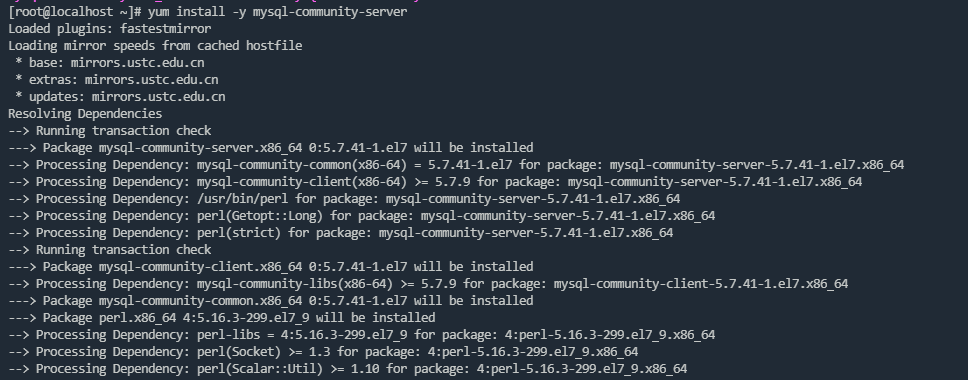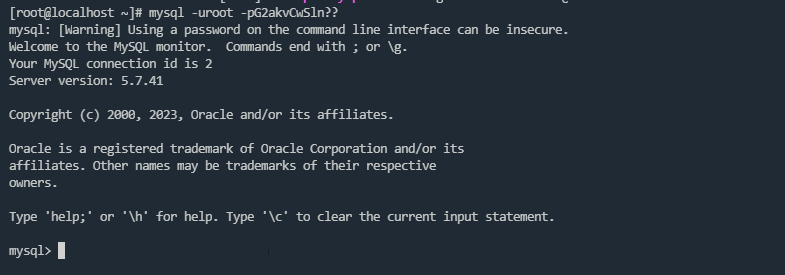Centos7 安装mysql 5.7 教程
安装 yum 源
需要在系统上启用 MySQL 5.7 Community Release YUM 存储库。用于 yum 存储库配置的 rpm 包可在 MySQL 的官方网站上找到。
首先将最新的MySQL GPG密钥导入您的系统
sudo rpm --import https://repo.mysql.com/RPM-GPG-KEY-mysql-2022
然后安装mysql源
sudo yum localinstall https://dev.mysql.com/get/mysql57-community-release-el7-11.noarch.rpm
用下面的命令检查 mysql 源是否安装成功
yum repolist enabled | grep "mysql.*-community.*"

出现这个画面表示mysql 源安装成功。
安装 MySQL
使用 yum install 命令安装
yum install -y mysql-community-server

启动 MySQL 服务
在 CentOS 7 下,新的启动/关闭服务的命令是 systemctl start|stop
systemctl start mysqld
systemctl stop mysqld
用 systemctl status 查看 MySQL 状态
systemctl status mysqld

这样表示Mysql已经成功运行。
设置开机启动
systemctl enable mysqld
重载所有修改过的配置文件
systemctl daemon-reload
修改 root 本地账户密码 mysql 安装完成之后,生成的默认密码在 /var/log/mysqld.log 文件中。使用 grep 命令找到日志中的密码。
grep 'temporary password' /var/log/mysqld.log
红框里面就是临时密码。
首次通过初始密码登录
shell> mysql -uroot -pG2akvCwSln??

note: 远程登录用-h 端口-P。
修改密码
mysql> use mysql;
mysql> alter user root@localhost identified by '123';
mysql> flush privileges;注意:mysql 5.7 默认安装了密码安全检查插件(validate_password),默认密码检查策略要求密码必须包含:大小写字母、数字和特殊符号,并且长度不能少于8位。
否则会提示 ERROR 1819 (HY000): Your password does not satisfy the current policy requirements 错误。查看 MySQL官网密码详细策略
测试环境可以调整密码的验证强度等级,设置 validate_password_policy 的全局参数为 LOW 即可,
输入设值语句 “ set global validate_password_policy=LOW; ” 进行设值。
允许远程访问
首先检查防火墙是否开启
firewall-cmd --state

开启3306端口
firewall-cmd --zone=public --add-port=3306/tcp --permanent # 开放3306端口 firewall-cmd --reload # 配置立即生效
用telnet验证是否连得通

修改允许root远程连接
mysql> use mysql; mysql>update user set host='%' where user='root';mysql> flush privileges;
更改my.cnf配置文件
vim /etc/my.cnf
[mysqld] datadir=/data/mysql socket=/tmp/mysql.sock lc-messages-dir=/usr/share/mysql/english/ explicit_defaults_for_timestamp=true #back_log值指在MySQL暂时停止回答新请求之前的短时间内多少个请求可以被存在堆栈中。和内核tcp_max_syn_backlog有关系。 back_log=2048 max_connections=10240 max_connect_errors=1000 connect-timeout=60 net_read_timeout=120 net_write_timeout=120 wait_timeout = 31536000 interactive_timeout = 31536000 max_allowed_packet=64M #服务器缓存线程,如果新连接非常多,增大这个值可以改善性能。默认公式:8 + (max_connections / 100) thread_cache_size=300 #线程打开表缓存数量,可以检查SHOW GLOBAL STATUS LIKE 'Opened_tables'; table_open_cache=5000 #用户可以创建的内存表(memory table)的大小.这个值用来计算内存表的最大行数值。 max_heap_table_size=512M #控制内存临时表的最大值,超过限值后就往硬盘写,写的位置由变量 tmpdir 决定 tmp_table_size=2G #随机读取数据缓冲区使用内存(MySQL的文档警告:“在Linux上,存在256KB和2MB的阈值,其中较大的值可能会显着减慢内存分配,因此您应考虑保持在其中一个值以下。” 避免将sort_buffer_size增加到2M以上,因为这会降低性能,从而降低收益。) sort_buffer_size=1M join_buffer_size=1M #查询缓冲,MySQL将查询结果存放在缓冲区中,今后对于同样的SELECT语句(区分大小写),将直接从缓冲区中读取结果。 query_cache_size=1G query_cache_type=1 query_cache_limit=128M default_storage_engine=INNODB #该参数对性能影响很大一般设置内存为系统内存的百分70-80。 innodb_buffer_pool_size=3G innodb_data_file_path=ibdata1:10M:autoextend #innodb_flush_log_at_trx_commit该参数对性能影响很大,如果不是特别对数据很重要的,设置为2。 #设置为0时,每秒写入一次日志并将其刷新到磁盘。未刷新日志的事务可能会在崩溃中丢失。 #默认设置1。每次事务提交时,日志都会写入并刷新到磁盘。 #设置为2时,在每次事务提交后写入日志,并每秒刷新一次到磁盘。未刷新日志的事务可能会在崩溃中丢失。 innodb_flush_log_at_trx_commit=2 innodb_log_buffer_size=32M innodb_log_file_size=512M innodb_log_files_in_group=3 innodb_io_capacity=3000 innodb_io_capacity_max=12000 innodb_max_dirty_pages_pct=90 innodb_lock_wait_timeout=120 #fdatasync模式:写数据时,write这一步并不需要真正写到磁盘才算完成(可能写入到操作系统buffer中就会返回完成),真正完成是flush操作,buffer交给操作系统去flush,并且文件的元数据信息也都需要更新到磁盘。 #O_DSYNC模式:写日志操作是在write这步完成,而数据文件的写入是在flush这步通过fsync完成 #O_DIRECT模式:数据文件的写入操作是直接从mysql innodb buffer到磁盘的,并不用通过操作系统的缓冲,而真正的完成也是在flush这步,日志还是要经过OS缓冲 innodb_flush_method=O_DIRECT thread_stack=192K long_query_time=1 sync_binlog=1 binlog_format=mixed default-time-zone = '+8:00' default-storage-engine=INNODB lower_case_table_names=1 sql_mode=ERROR_FOR_DIVISION_BY_ZERO,NO_AUTO_CREATE_USER,NO_ENGINE_SUBSTITUTION log_timestamps=SYSTEM symbolic-links=0 log-error=/var/log/mysqld.log pid-file=/var/run/mysqld/mysqld.pid slow_query_log = 1 slow-query_log_file = /var/log/mysql-slow.log long_query_time = 10 server-id=1 log_bin=/data/mysql/master01-bin.log binlog-ignore-db=mysql binlog-ignore-db=information_schema binlog-ignore-db=performance_schema binlog-ignore-db=sys binlog_cache_size=32M expire_logs_days=31 slave_skip_errors=1062 [client] port = 3306 socket = /tmp/mysql.sock
重新启动服务
systemctl restart mysqld
会提示报错失败,查看报错原因
journalctl -xe
Mysql启动报错:InnoDB: Operating system error number 13 in a file operation的解决方法
解决方案参考:https://blog.csdn.net/qq_32077121/article/details/119800587
解决方案:
[root@localhost ~]# getenforce //查看selinux状态 Enforcing [root@localhost ~]# setenforce 0 //临时关闭selinux,重启后失效 [root@localhost ~]# getenforce Permissive [root@localhost ~]# systemctl start mysqld //启动mysql服务成功 [root@localhost ~]# ss -antulp | grep :3306 tcp LISTEN 0 80 [::]:3306 [::]:* users:(("mysqld",pid=74057,fd=17))
永久关闭selinux
[root@localhost ~]# cat /etc/selinux/config # This file controls the state of SELinux on the system. # SELINUX= can take one of these three values: # enforcing - SELinux security policy is enforced. # permissive - SELinux prints warnings instead of enforcing. # disabled - No SELinux policy is loaded. SELINUX=enforcing # SELINUXTYPE= can take one of three two values: # targeted - Targeted processes are protected, # minimum - Modification of targeted policy. Only selected processes are protected. # mls - Multi Level Security protection. SELINUXTYPE=targeted
备份配置文件
[root@localhost ~]# cp -r /etc/selinux/config /etc/selinux/config.bak [root@localhost ~]# sed -i 's/SELINUX=enforcing/\SELINUX=disabled/' /etc/selinux/config [root@localhost ~]# cat /etc/selinux/config # This file controls the state of SELinux on the system. # SELINUX= can take one of these three values: # enforcing - SELinux security policy is enforced. # permissive - SELinux prints warnings instead of enforcing. # disabled - No SELinux policy is loaded. SELINUX=disabled # SELINUXTYPE= can take one of three two values: # targeted - Targeted processes are protected, # minimum - Modification of targeted policy. Only selected processes are protected. # mls - Multi Level Security protection. SELINUXTYPE=targeted
重新启动服务,查看状态

一个问题:更改mycnf.cn 发现root 密码突然不能使用了,只好按忘记密码的方法去处理,有知道为什么可以告诉一下。
默认配置文件路径:
配置文件:/etc/my.cnf
日志文件:/var/log/mysqld.log
服务启动脚本:/usr/lib/systemd/system/mysqld.service
socket文件:/var/run/mysqld/mysqld.pid
Linux下mysql5.7忘记root密码的解决方法:https://blog.csdn.net/hdyebd/article/details/89153934





【推荐】国内首个AI IDE,深度理解中文开发场景,立即下载体验Trae
【推荐】编程新体验,更懂你的AI,立即体验豆包MarsCode编程助手
【推荐】抖音旗下AI助手豆包,你的智能百科全书,全免费不限次数
【推荐】轻量又高性能的 SSH 工具 IShell:AI 加持,快人一步
· 分享一个免费、快速、无限量使用的满血 DeepSeek R1 模型,支持深度思考和联网搜索!
· 基于 Docker 搭建 FRP 内网穿透开源项目(很简单哒)
· ollama系列1:轻松3步本地部署deepseek,普通电脑可用
· 按钮权限的设计及实现
· 【杂谈】分布式事务——高大上的无用知识?